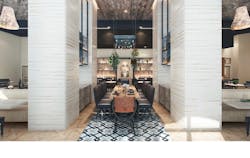Coverings: 4 Highlights about Tile and Stone in Hospitality and Residential Projects
It was an honor for me to be asked to moderate a panel on May 8 during Coverings’ annual show alongside James Wheeler, principal designer of J. Wheeler Designs; Elisa Gangone, NCIDQ, associate at ai3; and Gary Inman, vice president of hospitality at Baskervill. The talk, Seamless Design with Tile and Stone: Residential to Commercial and Back Again, looked at the influences of residential and commercial projects on each other (focusing primarily on hospitality), and the ways in which stone and tile fit into the mix.
It was a fascinating conversation, so I wanted to share a few keypoints with our readers:
1. Individuality is key, regardless of the type of space
While there are still many hospitality companies who want to create a sense of familiarity no matter the locale, individuality and uniqueness are becoming driving factors in hospitality design. Celebrating the neighborhood and communities where they reside, hotels are looking to portray a lifestyle, one where the local sightseeing doesn’t end the moment you step into the lobby. Inman pointed out that millennials—those born between 1982 and 2004—are driving this trend because they tend to value experiences over things, and lifestyle brands not only provide a continual experience, but also fall into the general price point of millennial lodgers.
The same desire for individuality is appearing in residential design as well. Wheeler pointed out that while a client may be more reserved about pushing the boundaries within their primary home, he’s seeing a lot of vacation or second homes that are designed to celebrate the surrounding community. This makes sense: homes are often the place of residence because of work or family obligations, but vacation or second homes are spaces that are bought because the owner loves to spend time in that place. Similar to hospitality, the reminder that you’re out of your normal habitat seeps into the interior design of these homes.
2. The hospitality industry notices that travelers are noticing AirBNB
It’s no surprise that the hospitality sector is feeling the waves companies like AirBNB are creating. Both Gangone and Inman stated that such companies are changing the ways in which hotels provide services. However, Gangone brought up an interesting comparison when she said that AirBNB is like any chain: there will be die-hard fans who only use the service in the same way that there are people who will only stay in a Hilton.
Regardless, hotels are looking to AirBNB to inform some of their decisions on providing the best local experience for their guests. One interesting point that was brought up, though, is that hoteliers are concerned about how AirBNB can operate like a hotel service without the same standards and codes that hotels have to adhere to. So hotels are looking to provide the same home-like feeling and comfort with the added benefit of security and safety.
While porcelain may not have been seen as the choice material in the past, advancements in technology have allowed it to fit into any interior and mimic just about any surface. Inman called porcelain a “savior” in that it provides a wide variety of textures, such as textile patterns, which couldn’t be used otherwise. Gangone stated that new porcelain tiles are capable of giving designers and end users the look they want at a price point and durability standard they need. She pointed out that while she would always love to use natural materials, porcelain doesn’t require the upkeep nor does it stain easily, so it often finds its way into projects where a natural look is desired. Wheeler said that the manufacturing side of the industry is working smarter, so that even small budgets can install a “really special” design.
The expansion of porcelain doesn’t mean stone is going away, however. Following a couple of questions which insinuated that the panel believed porcelain in many ways has pushed stone aside, all three were adamant that stone still has a very special place in design. Particularly for clients who want to use natural stone but need the durability and price of other materials, select pieces are being used as a focal point in both hotels and residential projects, as well as for specialty products such as lighting fixtures and furniture pieces. A jaw-dropping display of natural stone in the bathroom or as the focal point of a room turns the space into a luxury experience. Where price allows, stone is still being specified.
There is one project type where porcelain just won’t cut it—Inman said historic architecture being remodeled or renovated should be done with natural materials, which would pay homage to the original design.
About the Author

Kadie Yale
Former Editor-in-Chief
Kadie Yale holds a BA in Industrial Design from San Francisco State University and a MA in Decorative Art History and Theory from Parsons the New School. In her role as editor-in-chief from 2015-2018, she led the interiors+sources team in creating relevant content that touches on sustainability, universal design, science, and the role of design in society.
